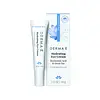What's inside
What's inside
 Key Ingredients
Key Ingredients

 Benefits
Benefits

 Concerns
Concerns

 Ingredients Side-by-side
Ingredients Side-by-side

Water
Skin ConditioningCaprylic/Capric Triglyceride
MaskingGlycerin
HumectantStearic Acid
CleansingCetyl Alcohol
EmollientGlyceryl Stearate Citrate
EmollientSodium Hyaluronate
HumectantHamamelis Virginiana Extract
AntiseborrhoeicCamellia Sinensis Leaf Extract
AntimicrobialTocopheryl Acetate
AntioxidantRetinyl Palmitate
Skin ConditioningAscorbyl Palmitate
AntioxidantPinus Pinaster Bark Extract
AntioxidantPanthenol
Skin ConditioningAloe Barbadensis Extract
Skin ConditioningSimmondsia Chinensis Seed Oil
EmollientXanthan Gum
EmulsifyingAllantoin
Skin ConditioningDimethicone
EmollientGlyceryl Stearate Se
EmulsifyingPotassium Sorbate
PreservativePhenoxyethanol
PreservativeEthylhexylglycerin
Skin ConditioningWater, Caprylic/Capric Triglyceride, Glycerin, Stearic Acid, Cetyl Alcohol, Glyceryl Stearate Citrate, Sodium Hyaluronate, Hamamelis Virginiana Extract, Camellia Sinensis Leaf Extract, Tocopheryl Acetate, Retinyl Palmitate, Ascorbyl Palmitate, Pinus Pinaster Bark Extract, Panthenol, Aloe Barbadensis Extract, Simmondsia Chinensis Seed Oil, Xanthan Gum, Allantoin, Dimethicone, Glyceryl Stearate Se, Potassium Sorbate, Phenoxyethanol, Ethylhexylglycerin
Water
Skin ConditioningCetyl Alcohol
EmollientCetearyl Alcohol
EmollientGlycerin
HumectantOlea Europaea Fruit Oil
MaskingHelianthus Annuus Seed Oil
EmollientCocos Nucifera Oil
MaskingCI 77947
Alcohol Denat.
AntimicrobialKaolin
AbrasiveCoco-Glucoside
CleansingGossypium Herbaceum Flower Extract
HumectantOryza Sativa Extract
AbsorbentBeta Vulgaris Root Extract
Skin ConditioningArtemisia Umbelliformis Extract
Skin ConditioningEuphrasia Officinalis Extract
AntimicrobialButyrospermum Parkii Butter
Skin ConditioningSaccharum Officinarum Extract
MoisturisingAloe Barbadensis Leaf Juice
Skin ConditioningCarrageenan
Ricinus Communis Seed Oil
MaskingSucrose
HumectantFructose
HumectantGlucose
HumectantInositol
HumectantCitric Acid
BufferingBenzoic Acid
MaskingLactic Acid
BufferingTrehalose
HumectantXanthan Gum
EmulsifyingPotassium Sorbate
PreservativeSodium Benzoate
MaskingSodium PCA
HumectantPhenoxyethanol
PreservativeWater, Cetyl Alcohol, Cetearyl Alcohol, Glycerin, Olea Europaea Fruit Oil, Helianthus Annuus Seed Oil, Cocos Nucifera Oil, CI 77947, Alcohol Denat., Kaolin, Coco-Glucoside, Gossypium Herbaceum Flower Extract, Oryza Sativa Extract, Beta Vulgaris Root Extract, Artemisia Umbelliformis Extract, Euphrasia Officinalis Extract, Butyrospermum Parkii Butter, Saccharum Officinarum Extract, Aloe Barbadensis Leaf Juice, Carrageenan, Ricinus Communis Seed Oil, Sucrose, Fructose, Glucose, Inositol, Citric Acid, Benzoic Acid, Lactic Acid, Trehalose, Xanthan Gum, Potassium Sorbate, Sodium Benzoate, Sodium PCA, Phenoxyethanol
Ingredients Explained
These ingredients are found in both products.
Ingredients higher up in an ingredient list are typically present in a larger amount.
Cetyl Alcohol is a fatty alcohol. Fatty Alcohols are most often used as an emollient or to thicken a product.
Its main roles are:
Though it has "alcohol" in the name, it is not related to denatured alcohol or ethyl alcohol.
The FDA allows products labeled "alcohol-free" to have fatty alcohols.
Learn more about Cetyl AlcoholGlycerin is already naturally found in your skin. It helps moisturize and protect your skin.
A study from 2016 found glycerin to be more effective as a humectant than AHAs and hyaluronic acid.
As a humectant, it helps the skin stay hydrated by pulling moisture to your skin. The low molecular weight of glycerin allows it to pull moisture into the deeper layers of your skin.
Hydrated skin improves your skin barrier; Your skin barrier helps protect against irritants and bacteria.
Glycerin has also been found to have antimicrobial and antiviral properties. Due to these properties, glycerin is often used in wound and burn treatments.
In cosmetics, glycerin is usually derived from plants such as soybean or palm. However, it can also be sourced from animals, such as tallow or animal fat.
This ingredient is organic, colorless, odorless, and non-toxic.
Glycerin is the name for this ingredient in American English. British English uses Glycerol/Glycerine.
Learn more about GlycerinPhenoxyethanol is a preservative that has germicide, antimicrobial, and aromatic properties. Studies show that phenoxyethanol can prevent microbial growth. By itself, it has a scent that is similar to that of a rose.
It's often used in formulations along with Caprylyl Glycol to preserve the shelf life of products.
Potassium Sorbate is a preservative used to prevent yeast and mold in products. It is commonly found in both cosmetic and food products.
This ingredient comes from potassium salt derived from sorbic acid. Sorbic acid is a natural antibiotic and effective against fungus.
Both potassium sorbate and sorbic acid can be found in baked goods, cheeses, dried meats, dried fruit, ice cream, pickles, wine, yogurt, and more.
You'll often find this ingredient used with other preservatives.
Learn more about Potassium SorbateWater. It's the most common cosmetic ingredient of all. You'll usually see it at the top of ingredient lists, meaning that it makes up the largest part of the product.
So why is it so popular? Water most often acts as a solvent - this means that it helps dissolve other ingredients into the formulation.
You'll also recognize water as that liquid we all need to stay alive. If you see this, drink a glass of water. Stay hydrated!
Learn more about WaterXanthan gum is used as a stabilizer and thickener within cosmetic products. It helps give products a sticky, thick feeling - preventing them from being too runny.
On the technical side of things, xanthan gum is a polysaccharide - a combination consisting of multiple sugar molecules bonded together.
Xanthan gum is a pretty common and great ingredient. It is a natural, non-toxic, non-irritating ingredient that is also commonly used in food products.
Learn more about Xanthan Gum